Features Version 3.0 (RC1) PVSS II V3.0
38 Slides873.00 KB
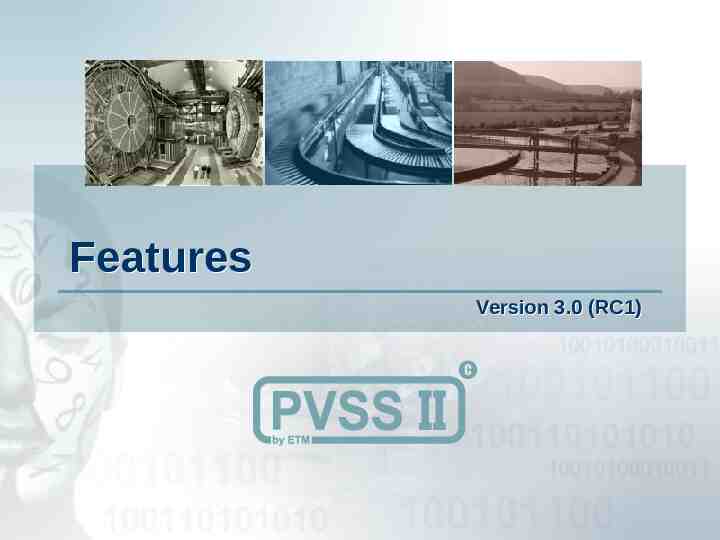
Features Version 3.0 (RC1) PVSS II V3.0
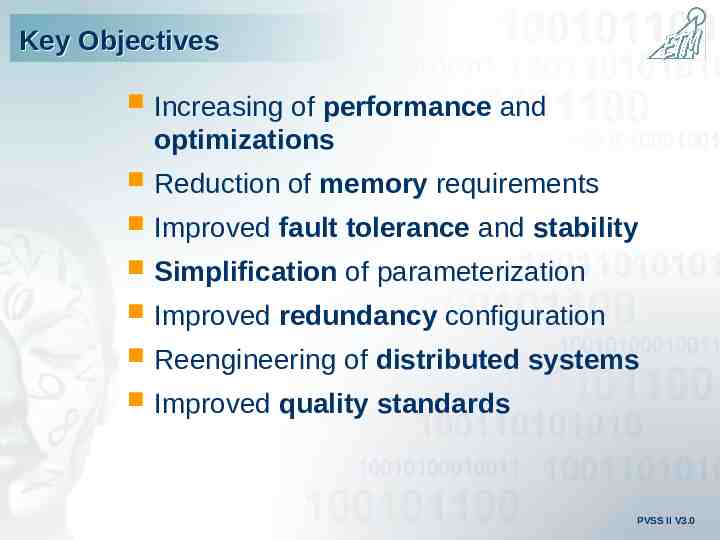
Key Objectives Increasing of performance and optimizations Reduction of memory requirements Improved fault tolerance and stability Simplification of parameterization Improved redundancy configuration Reengineering of distributed systems Improved quality standards PVSS II V3.0
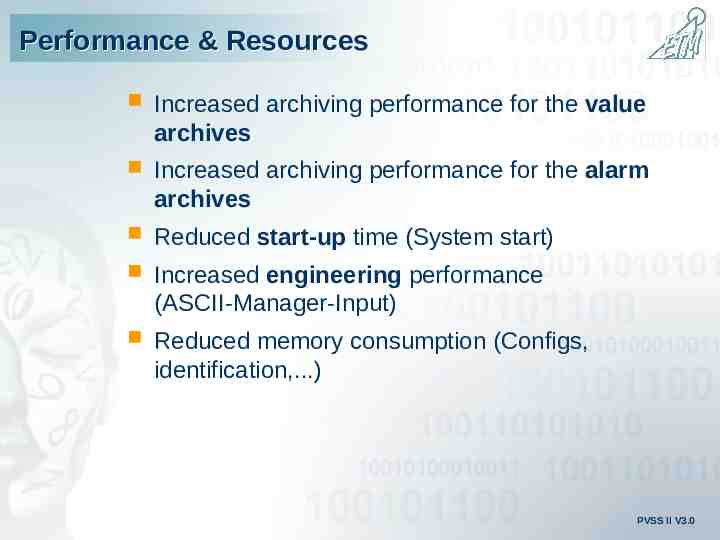
Performance & Resources Increased archiving performance for the value archives Increased archiving performance for the alarm archives Reduced start-up time (System start) Increased engineering performance (ASCII-Manager-Input) Reduced memory consumption (Configs, identification,.) PVSS II V3.0
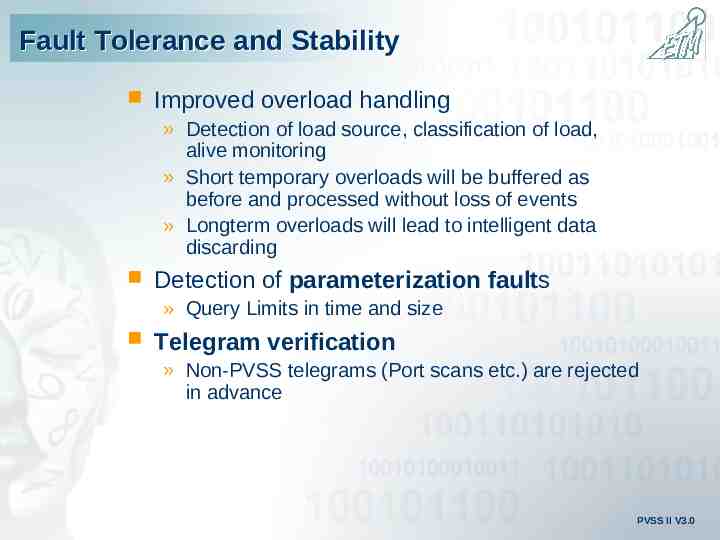
Fault Tolerance and Stability Improved overload handling » Detection of load source, classification of load, alive monitoring » Short temporary overloads will be buffered as before and processed without loss of events » Longterm overloads will lead to intelligent data discarding Detection of parameterization faults » Query Limits in time and size Telegram verification » Non-PVSS telegrams (Port scans etc.) are rejected in advance PVSS II V3.0
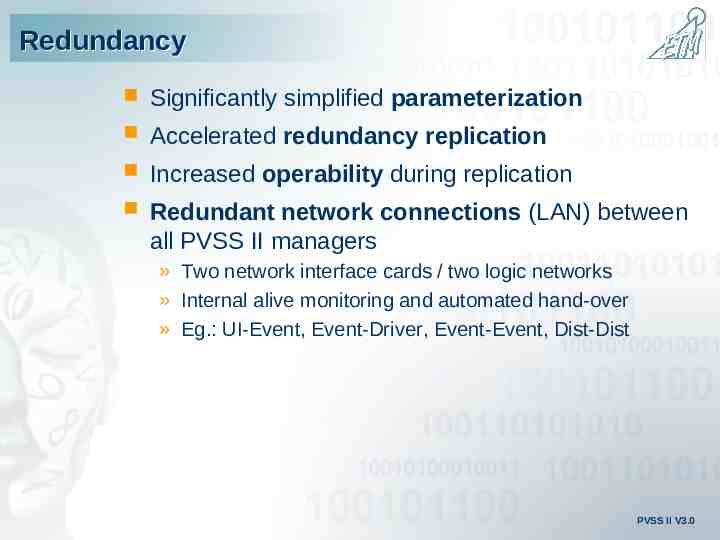
Redundancy Significantly simplified parameterization Accelerated redundancy replication Increased operability during replication Redundant network connections (LAN) between all PVSS II managers » Two network interface cards / two logic networks » Internal alive monitoring and automated hand-over » Eg.: UI-Event, Event-Driver, Event-Event, Dist-Dist PVSS II V3.0
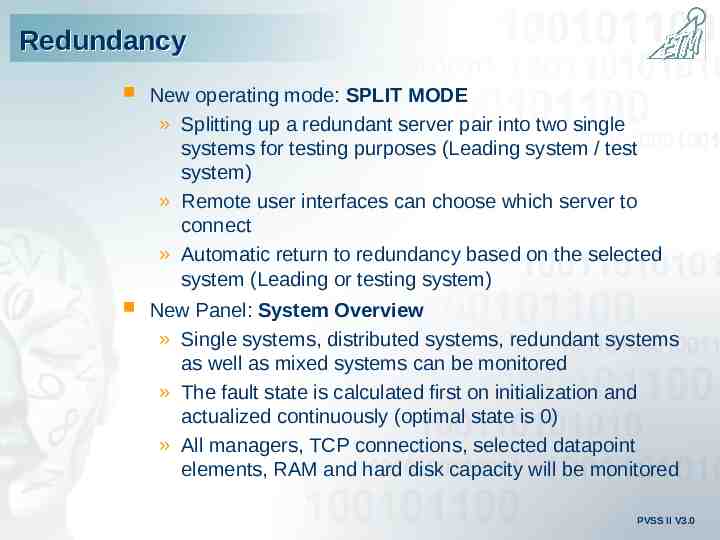
Redundancy New operating mode: SPLIT MODE » Splitting up a redundant server pair into two single systems for testing purposes (Leading system / test system) » Remote user interfaces can choose which server to connect » Automatic return to redundancy based on the selected system (Leading or testing system) New Panel: System Overview » Single systems, distributed systems, redundant systems as well as mixed systems can be monitored » The fault state is calculated first on initialization and actualized continuously (optimal state is 0) » All managers, TCP connections, selected datapoint elements, RAM and hard disk capacity will be monitored PVSS II V3.0
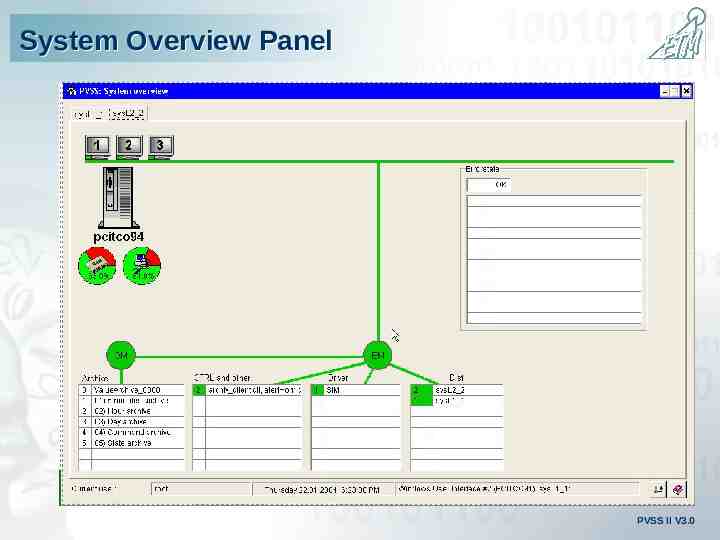
System Overview Panel PVSS II V3.0
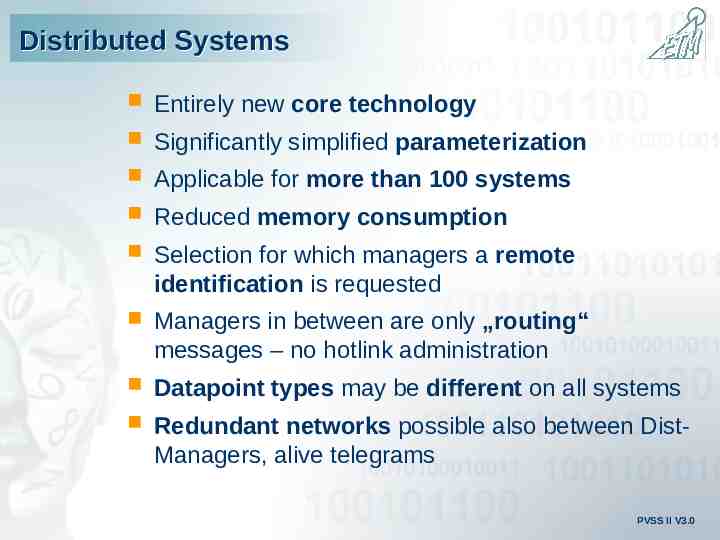
Distributed Systems Entirely new core technology Significantly simplified parameterization Applicable for more than 100 systems Reduced memory consumption Selection for which managers a remote identification is requested Managers in between are only „routing“ messages – no hotlink administration Datapoint types may be different on all systems Redundant networks possible also between Dist- Managers, alive telegrams PVSS II V3.0
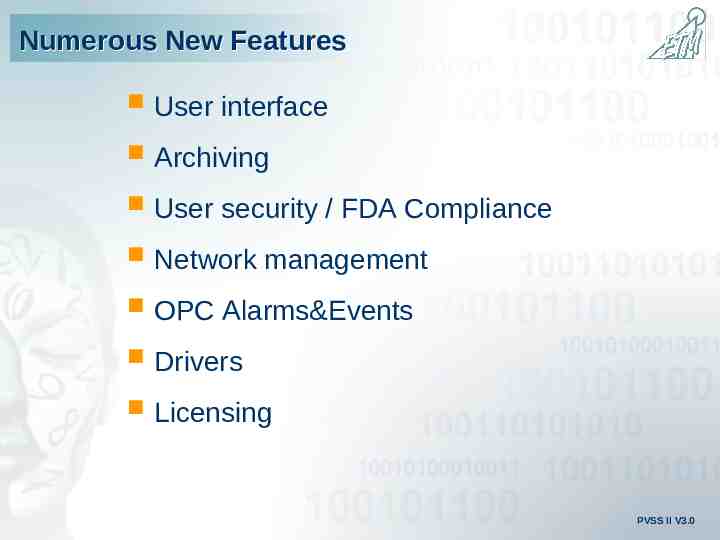
Numerous New Features User interface Archiving User security / FDA Compliance Network management OPC Alarms&Events Drivers Licensing PVSS II V3.0
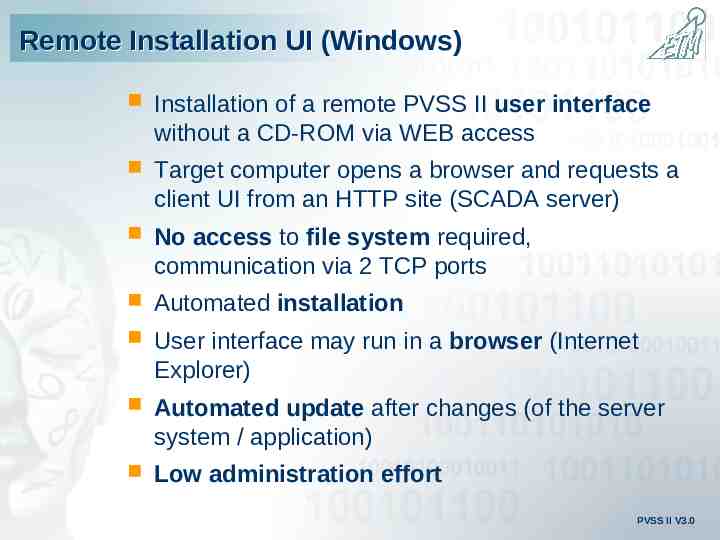
Remote Installation UI (Windows) Installation of a remote PVSS II user interface without a CD-ROM via WEB access Target computer opens a browser and requests a client UI from an HTTP site (SCADA server) No access to file system required, communication via 2 TCP ports Automated installation User interface may run in a browser (Internet Explorer) Automated update after changes (of the server system / application) Low administration effort PVSS II V3.0
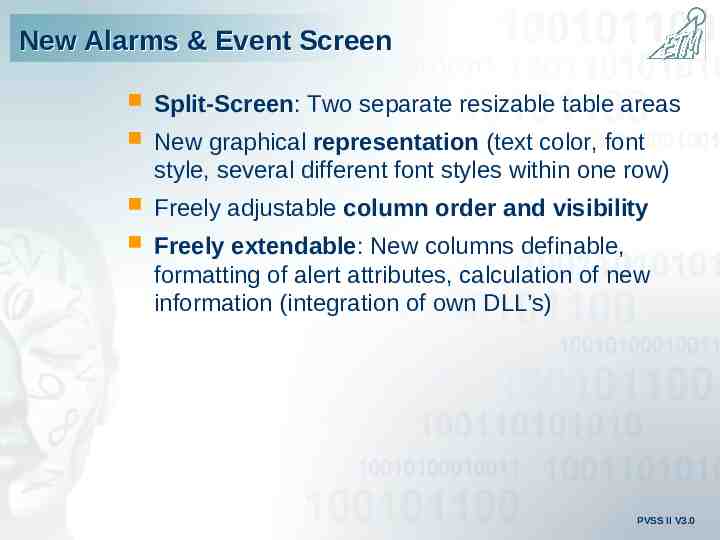
New Alarms & Event Screen Split-Screen: Two separate resizable table areas New graphical representation (text color, font style, several different font styles within one row) Freely adjustable column order and visibility Freely extendable: New columns definable, formatting of alert attributes, calculation of new information (integration of own DLL’s) PVSS II V3.0
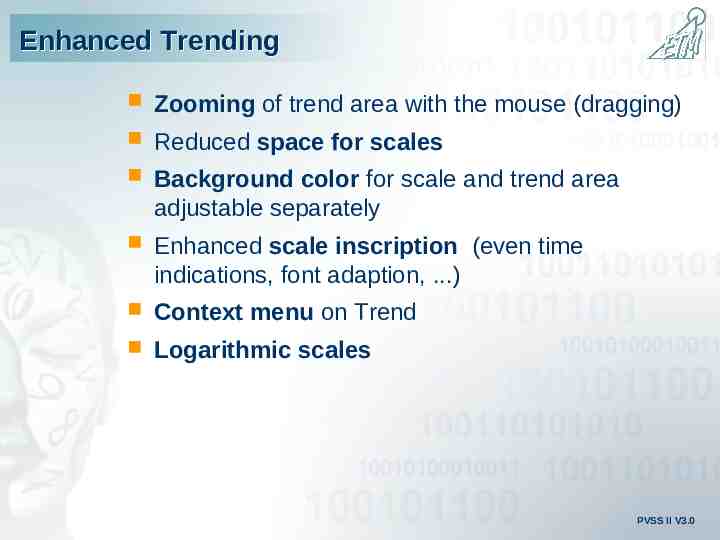
Enhanced Trending Zooming of trend area with the mouse (dragging) Reduced space for scales Background color for scale and trend area adjustable separately Enhanced scale inscription (even time indications, font adaption, .) Context menu on Trend Logarithmic scales PVSS II V3.0
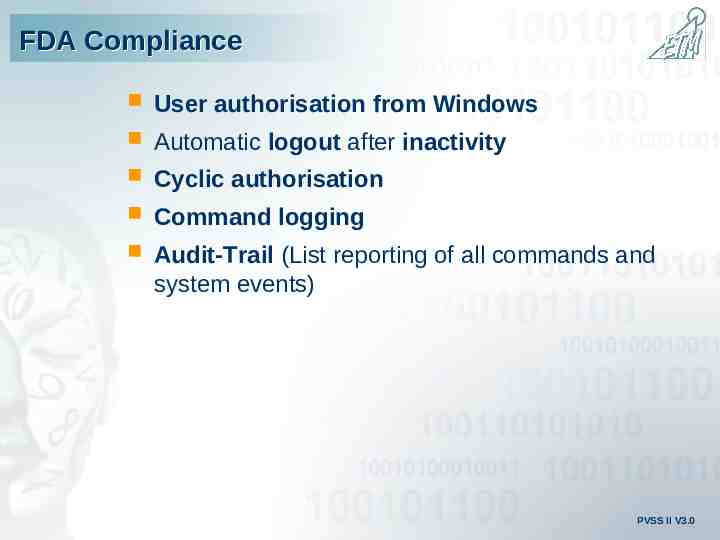
FDA Compliance User authorisation from Windows Automatic logout after inactivity Cyclic authorisation Command logging Audit-Trail (List reporting of all commands and system events) PVSS II V3.0
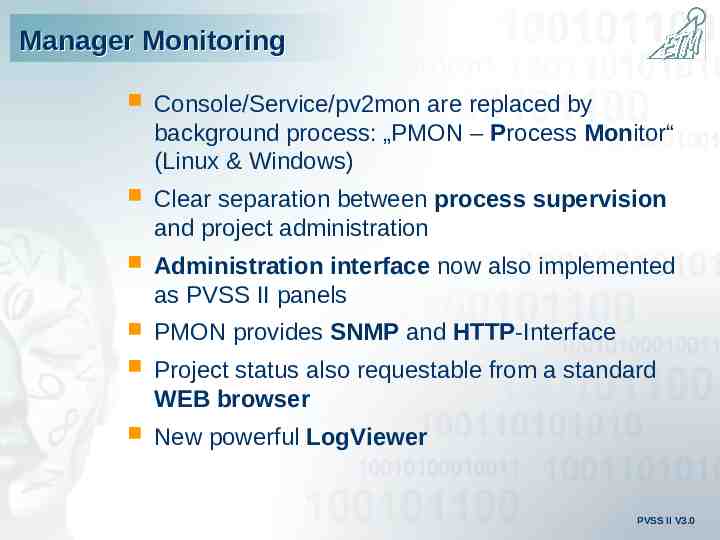
Manager Monitoring Console/Service/pv2mon are replaced by background process: „PMON – Process Monitor“ (Linux & Windows) Clear separation between process supervision and project administration Administration interface now also implemented as PVSS II panels PMON provides SNMP and HTTP-Interface Project status also requestable from a standard WEB browser New powerful LogViewer PVSS II V3.0
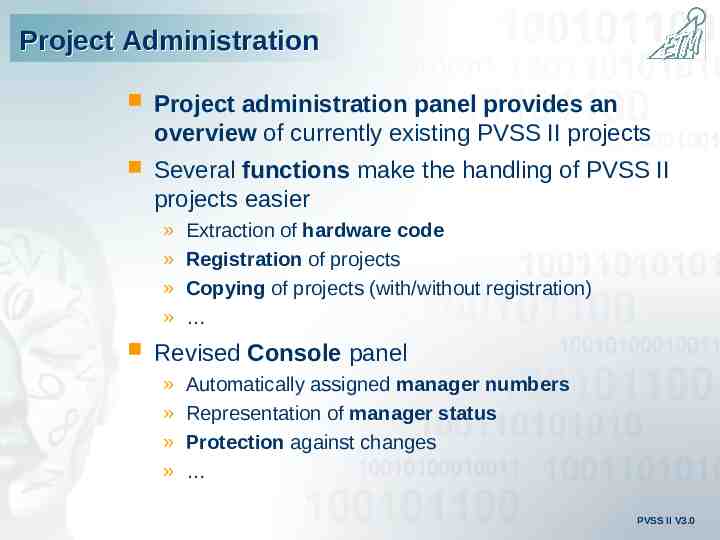
Project Administration Project administration panel provides an overview of currently existing PVSS II projects Several functions make the handling of PVSS II projects easier » » » » Extraction of hardware code Registration of projects Copying of projects (with/without registration) Revised Console panel » Automatically assigned manager numbers » Representation of manager status » Protection against changes » PVSS II V3.0
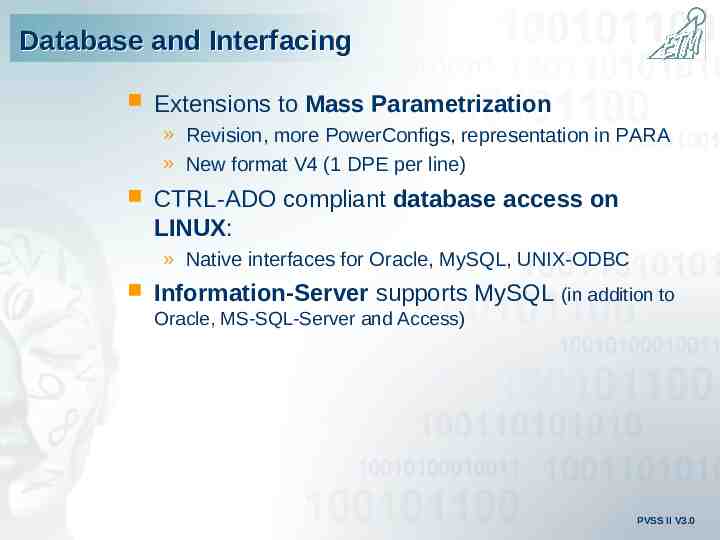
Database and Interfacing Extensions to Mass Parametrization » Revision, more PowerConfigs, representation in PARA » New format V4 (1 DPE per line) CTRL-ADO compliant database access on LINUX: » Native interfaces for Oracle, MySQL, UNIX-ODBC Information-Server supports MySQL (in addition to Oracle, MS-SQL-Server and Access) PVSS II V3.0
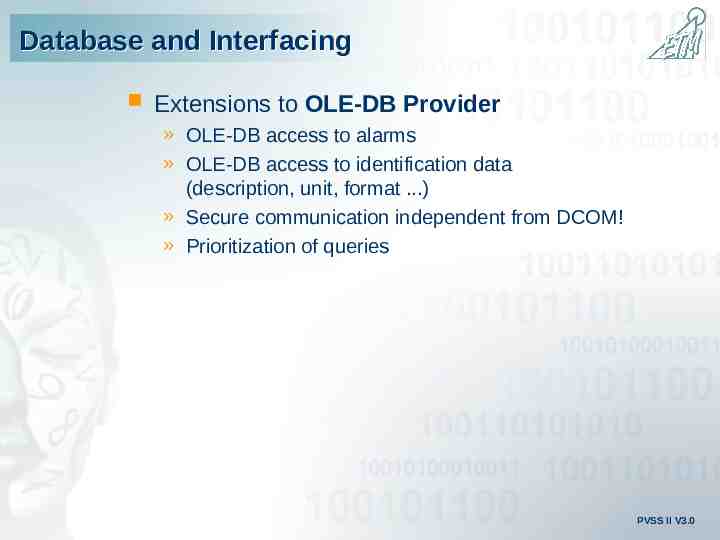
Database and Interfacing Extensions to OLE-DB Provider » OLE-DB access to alarms » OLE-DB access to identification data (description, unit, format .) » Secure communication independent from DCOM! » Prioritization of queries PVSS II V3.0
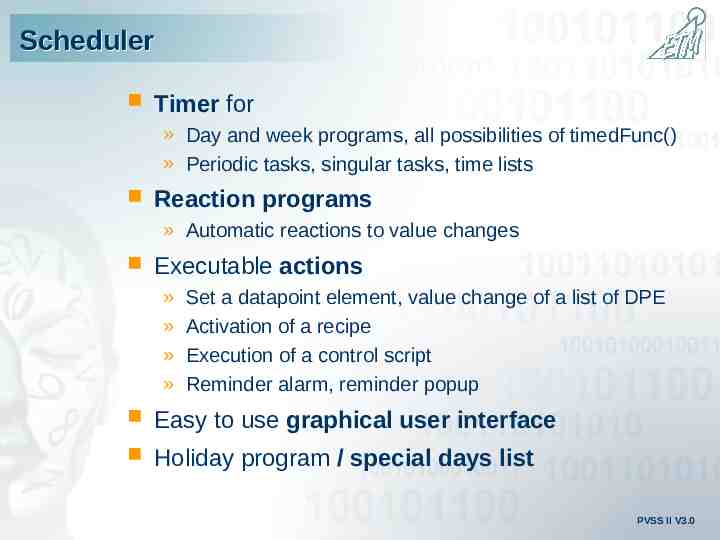
Scheduler Timer for » Day and week programs, all possibilities of timedFunc() » Periodic tasks, singular tasks, time lists Reaction programs » Automatic reactions to value changes Executable actions » Set a datapoint element, value change of a list of DPE » Activation of a recipe » Execution of a control script » Reminder alarm, reminder popup Easy to use graphical user interface Holiday program / special days list PVSS II V3.0
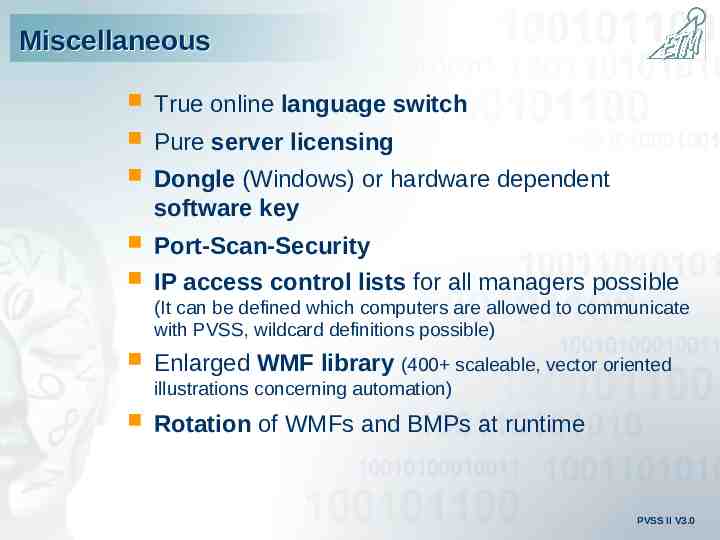
Miscellaneous True online language switch Pure server licensing Dongle (Windows) or hardware dependent software key Port-Scan-Security IP access control lists for all managers possible (It can be defined which computers are allowed to communicate with PVSS, wildcard definitions possible) Enlarged WMF library (400 scaleable, vector oriented illustrations concerning automation) Rotation of WMFs and BMPs at runtime PVSS II V3.0
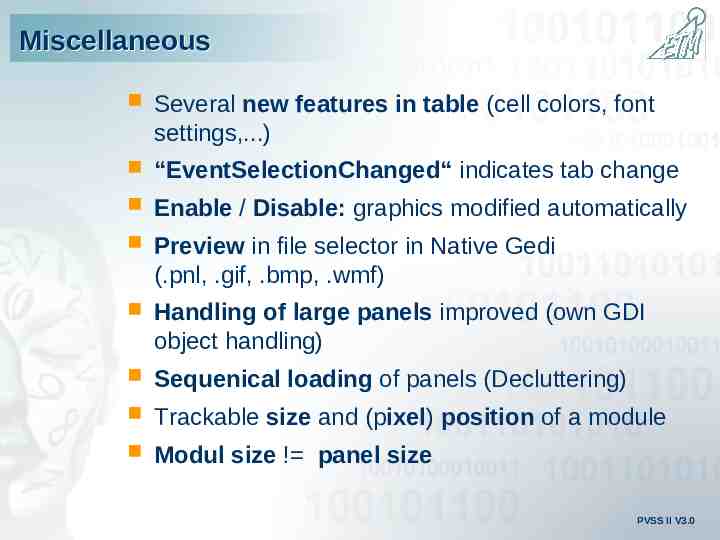
Miscellaneous Several new features in table (cell colors, font settings,.) “EventSelectionChanged“ indicates tab change Enable / Disable: graphics modified automatically Preview in file selector in Native Gedi (.pnl, .gif, .bmp, .wmf) Handling of large panels improved (own GDI object handling) Sequenical loading of panels (Decluttering) Trackable size and (pixel) position of a module Modul size ! panel size PVSS II V3.0
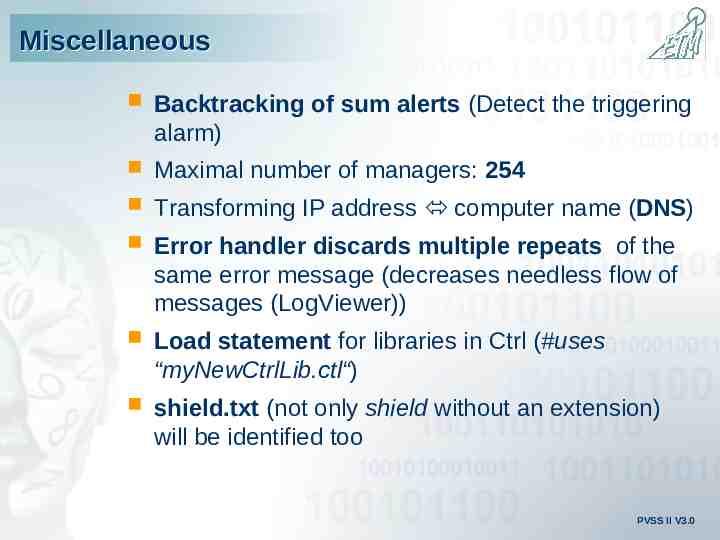
Miscellaneous Backtracking of sum alerts (Detect the triggering alarm) Maximal number of managers: 254 Transforming IP address computer name (DNS) Error handler discards multiple repeats of the same error message (decreases needless flow of messages (LogViewer)) Load statement for libraries in Ctrl (#uses “myNewCtrlLib.ctl“) shield.txt (not only shield without an extension) will be identified too PVSS II V3.0
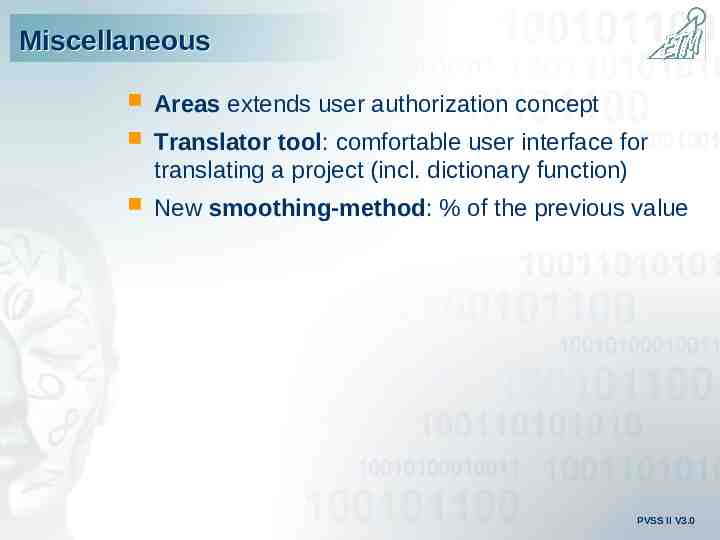
Miscellaneous Areas extends user authorization concept Translator tool: comfortable user interface for translating a project (incl. dictionary function) New smoothing-method: % of the previous value PVSS II V3.0
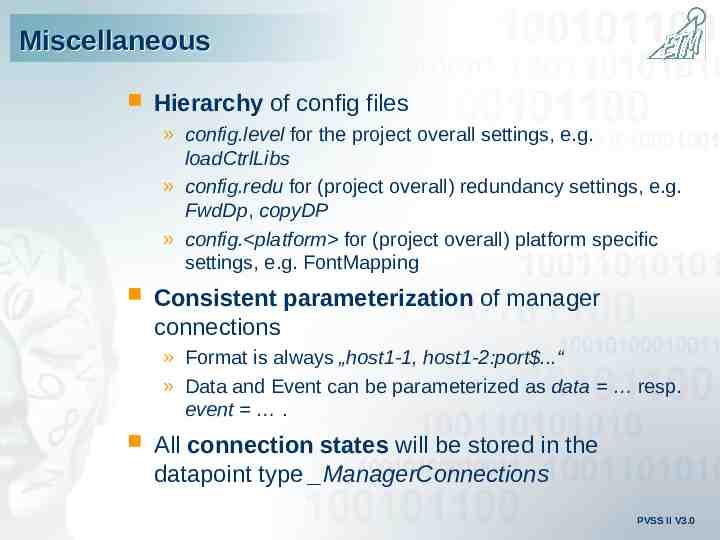
Miscellaneous Hierarchy of config files » config.level for the project overall settings, e.g. loadCtrlLibs » config.redu for (project overall) redundancy settings, e.g. FwdDp, copyDP » config. platform for (project overall) platform specific settings, e.g. FontMapping Consistent parameterization of manager connections » Format is always „host1-1, host1-2:port .“ » Data and Event can be parameterized as data resp. event . All connection states will be stored in the datapoint type ManagerConnections PVSS II V3.0
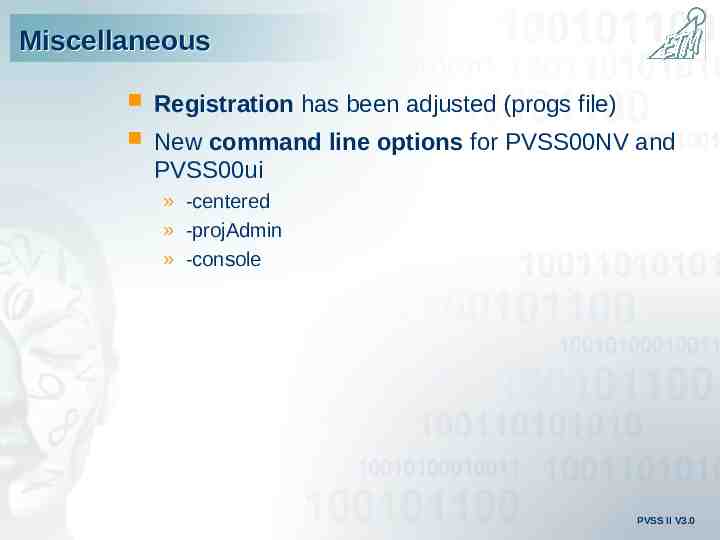
Miscellaneous Registration has been adjusted (progs file) New command line options for PVSS00NV and PVSS00ui » -centered » -projAdmin » -console PVSS II V3.0
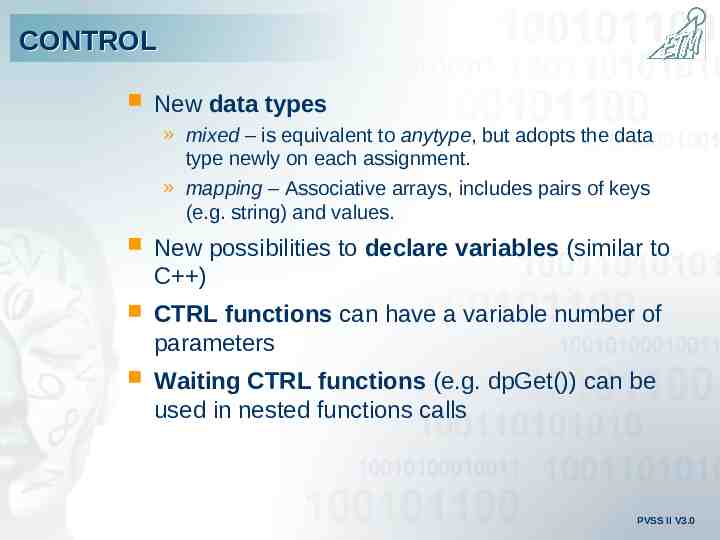
CONTROL New data types » mixed – is equivalent to anytype, but adopts the data type newly on each assignment. » mapping – Associative arrays, includes pairs of keys (e.g. string) and values. New possibilities to declare variables (similar to C ) CTRL functions can have a variable number of parameters Waiting CTRL functions (e.g. dpGet()) can be used in nested functions calls PVSS II V3.0
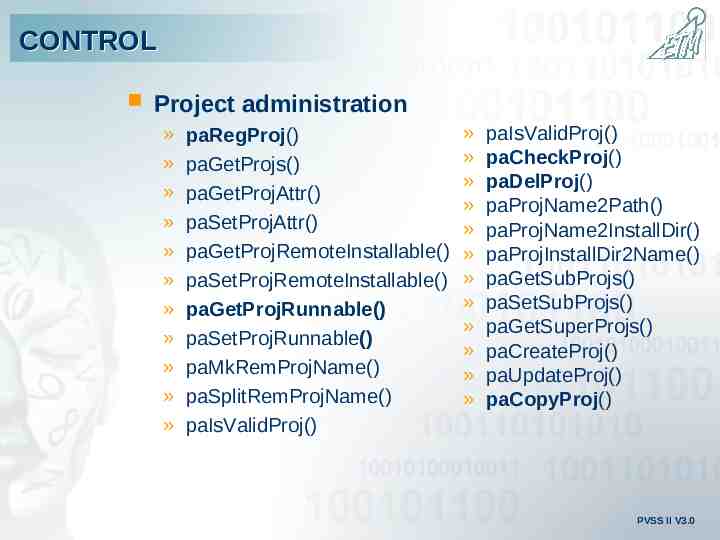
CONTROL Project administration » paRegProj() » paGetProjs() » paGetProjAttr() » paSetProjAttr() » paGetProjRemoteInstallable() » paSetProjRemoteInstallable() » paGetProjRunnable() » paSetProjRunnable() » paMkRemProjName() » paSplitRemProjName() » paIsValidProj() » » » » » » » » » » » » paIsValidProj() paCheckProj() paDelProj() paProjName2Path() paProjName2InstallDir() paProjInstallDir2Name() paGetSubProjs() paSetSubProjs() paGetSuperProjs() paCreateProj() paUpdateProj() paCopyProj() PVSS II V3.0
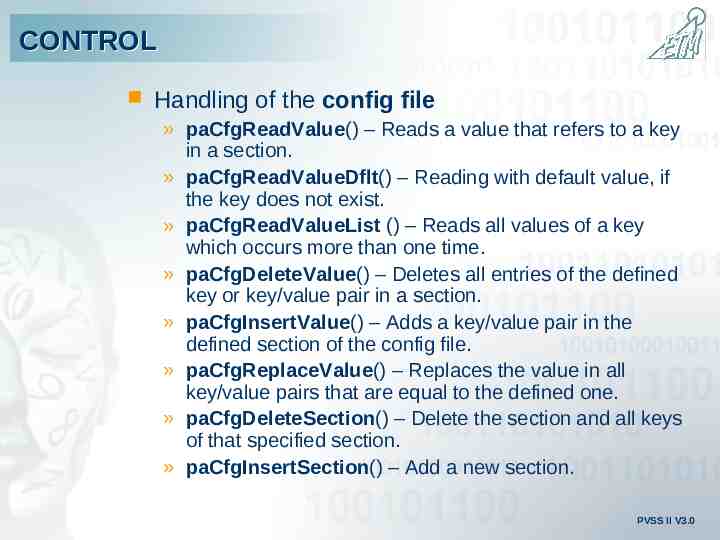
CONTROL Handling of the config file » paCfgReadValue() – Reads a value that refers to a key in a section. » paCfgReadValueDflt() – Reading with default value, if the key does not exist. » paCfgReadValueList () – Reads all values of a key which occurs more than one time. » paCfgDeleteValue() – Deletes all entries of the defined key or key/value pair in a section. » paCfgInsertValue() – Adds a key/value pair in the defined section of the config file. » paCfgReplaceValue() – Replaces the value in all key/value pairs that are equal to the defined one. » paCfgDeleteSection() – Delete the section and all keys of that specified section. » paCfgInsertSection() – Add a new section. PVSS II V3.0
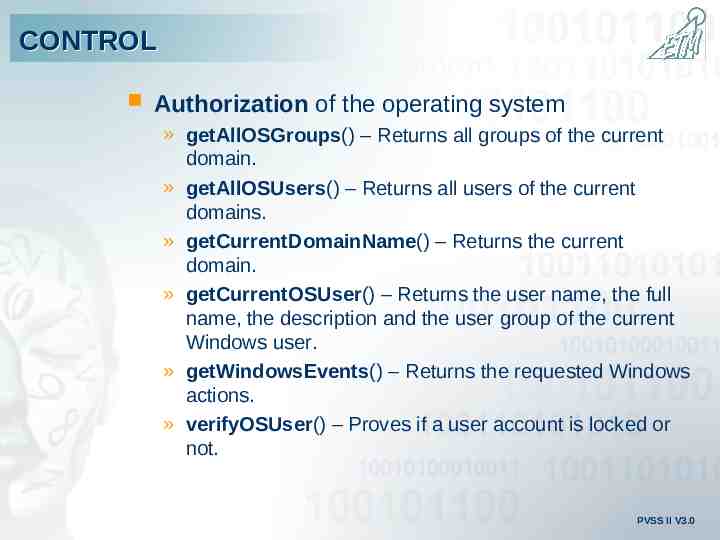
CONTROL Authorization of the operating system » getAllOSGroups() – Returns all groups of the current domain. » getAllOSUsers() – Returns all users of the current domains. » getCurrentDomainName() – Returns the current domain. » getCurrentOSUser() – Returns the user name, the full name, the description and the user group of the current Windows user. » getWindowsEvents() – Returns the requested Windows actions. » verifyOSUser() – Proves if a user account is locked or not. PVSS II V3.0
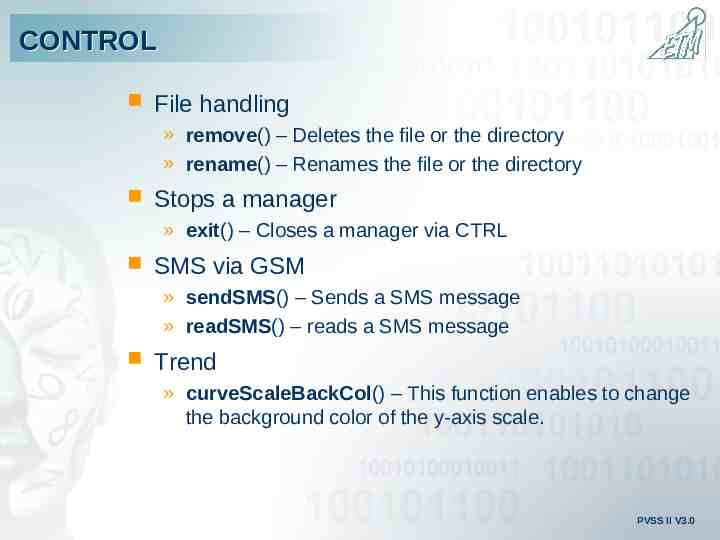
CONTROL File handling » remove() – Deletes the file or the directory » rename() – Renames the file or the directory Stops a manager » exit() – Closes a manager via CTRL SMS via GSM » sendSMS() – Sends a SMS message » readSMS() – reads a SMS message Trend » curveScaleBackCol() – This function enables to change the background color of the y-axis scale. PVSS II V3.0
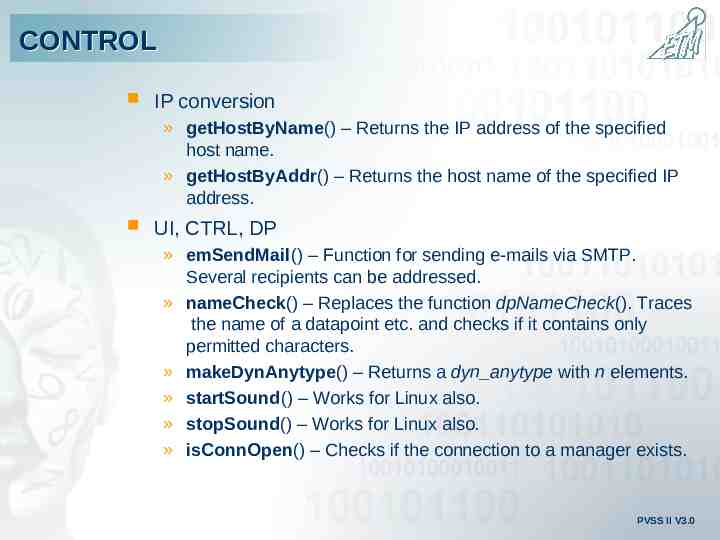
CONTROL IP conversion » getHostByName() – Returns the IP address of the specified host name. » getHostByAddr() – Returns the host name of the specified IP address. UI, CTRL, DP » emSendMail() – Function for sending e-mails via SMTP. Several recipients can be addressed. » nameCheck() – Replaces the function dpNameCheck(). Traces the name of a datapoint etc. and checks if it contains only permitted characters. » makeDynAnytype() – Returns a dyn anytype with n elements. » startSound() – Works for Linux also. » stopSound() – Works for Linux also. » isConnOpen() – Checks if the connection to a manager exists. PVSS II V3.0
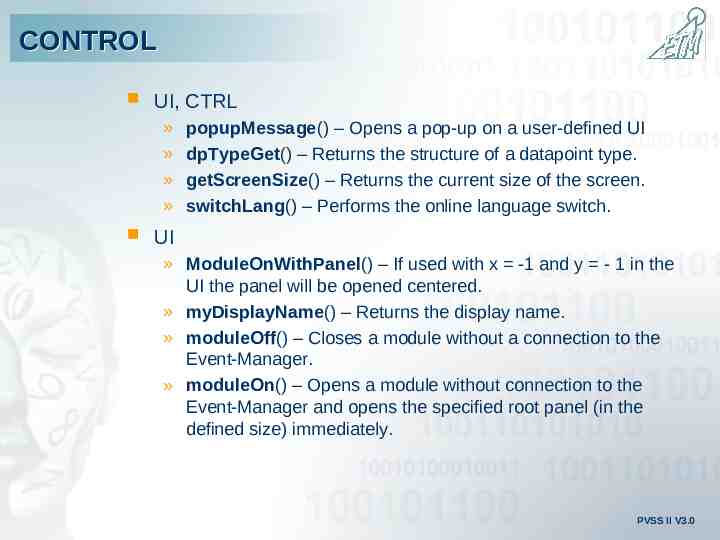
CONTROL UI, CTRL » » » » popupMessage() – Opens a pop-up on a user-defined UI dpTypeGet() – Returns the structure of a datapoint type. getScreenSize() – Returns the current size of the screen. switchLang() – Performs the online language switch. UI » ModuleOnWithPanel() – If used with x -1 and y - 1 in the UI the panel will be opened centered. » myDisplayName() – Returns the display name. » moduleOff() – Closes a module without a connection to the Event-Manager. » moduleOn() – Opens a module without connection to the Event-Manager and opens the specified root panel (in the defined size) immediately. PVSS II V3.0
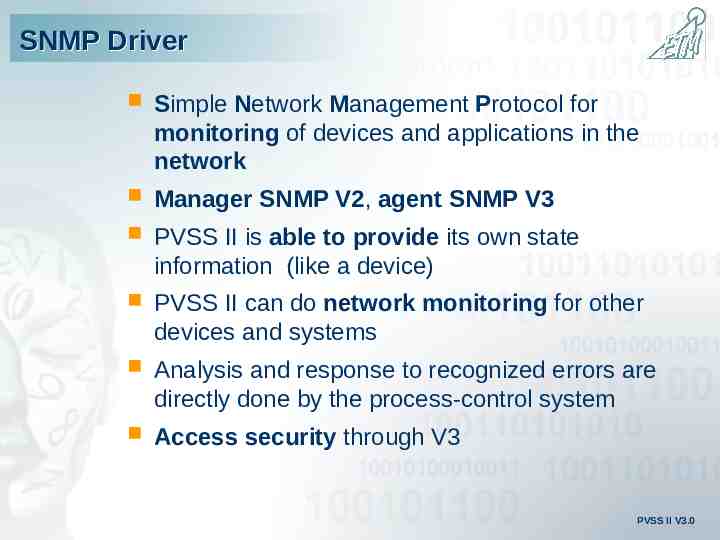
SNMP Driver Simple Network Management Protocol for monitoring of devices and applications in the network Manager SNMP V2, agent SNMP V3 PVSS II is able to provide its own state information (like a device) PVSS II can do network monitoring for other devices and systems Analysis and response to recognized errors are directly done by the process-control system Access security through V3 PVSS II V3.0
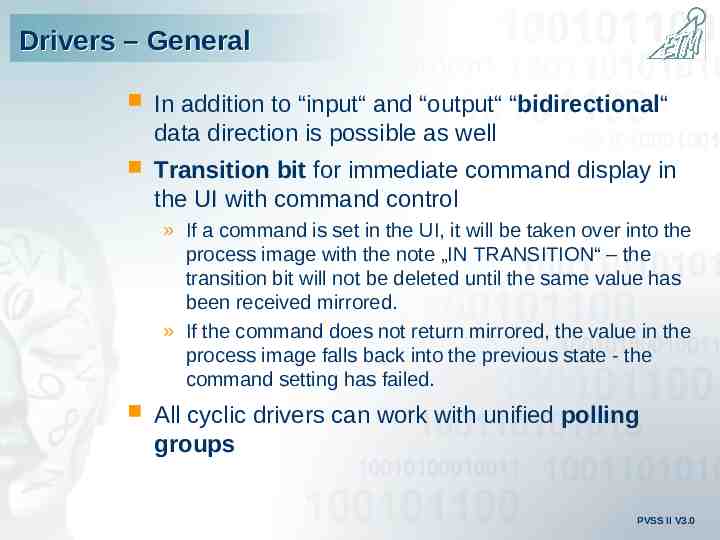
Drivers – General In addition to “input“ and “output“ “bidirectional“ data direction is possible as well Transition bit for immediate command display in the UI with command control » If a command is set in the UI, it will be taken over into the process image with the note „IN TRANSITION“ – the transition bit will not be deleted until the same value has been received mirrored. » If the command does not return mirrored, the value in the process image falls back into the previous state - the command setting has failed. All cyclic drivers can work with unified polling groups PVSS II V3.0
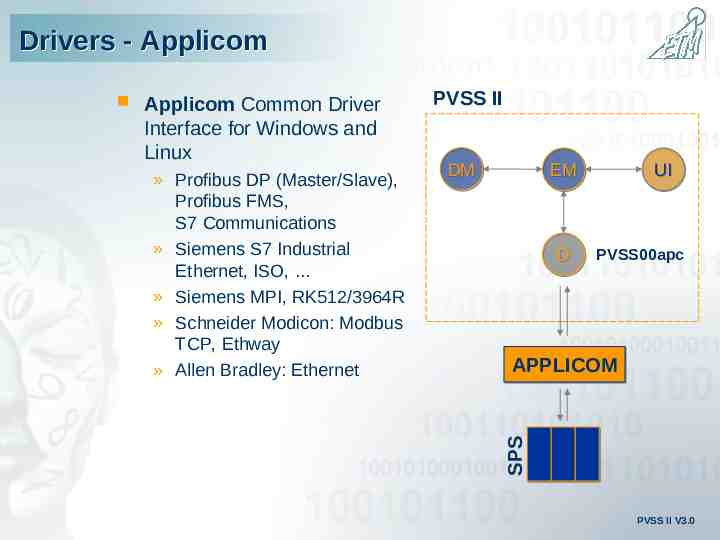
Drivers - Applicom Interface for Windows and Linux » Profibus DP (Master/Slave), Profibus FMS, S7 Communications » Siemens S7 Industrial Ethernet, ISO, . » Siemens MPI, RK512/3964R » Schneider Modicon: Modbus TCP, Ethway » Allen Bradley: Ethernet PVSS II DM EM D UI PVSS00apc APPLICOM SPS Applicom Common Driver PVSS II V3.0
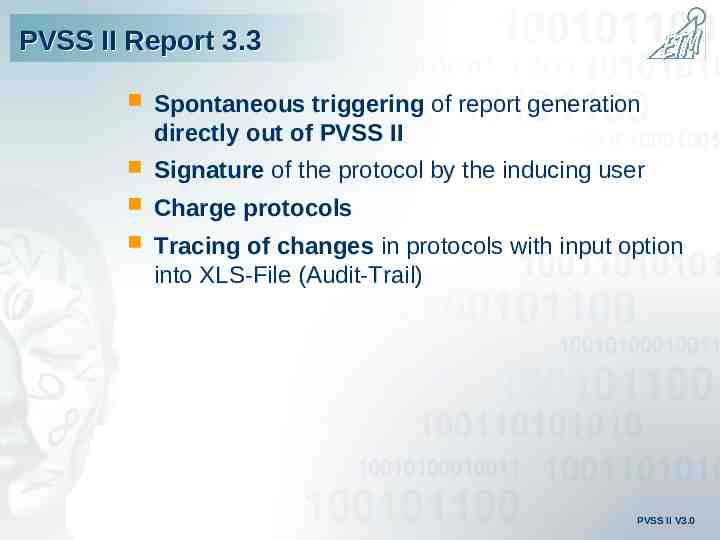
PVSS II Report 3.3 Spontaneous triggering of report generation directly out of PVSS II Signature of the protocol by the inducing user Charge protocols Tracing of changes in protocols with input option into XLS-File (Audit-Trail) PVSS II V3.0
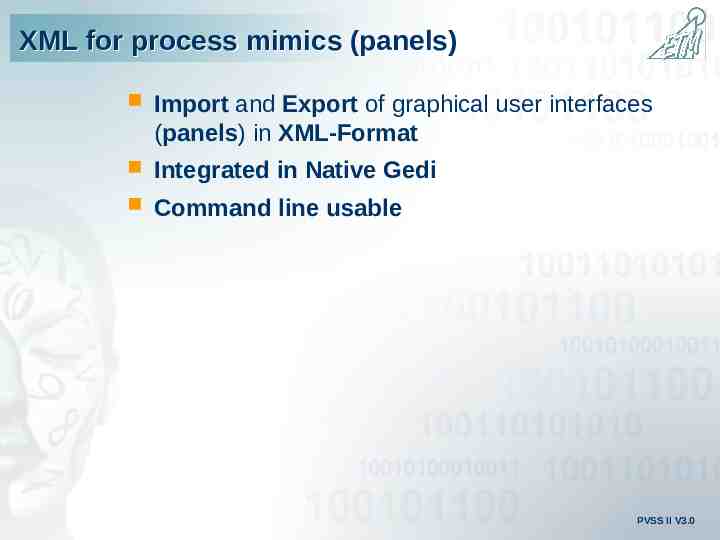
XML for process mimics (panels) Import and Export of graphical user interfaces (panels) in XML-Format Integrated in Native Gedi Command line usable PVSS II V3.0
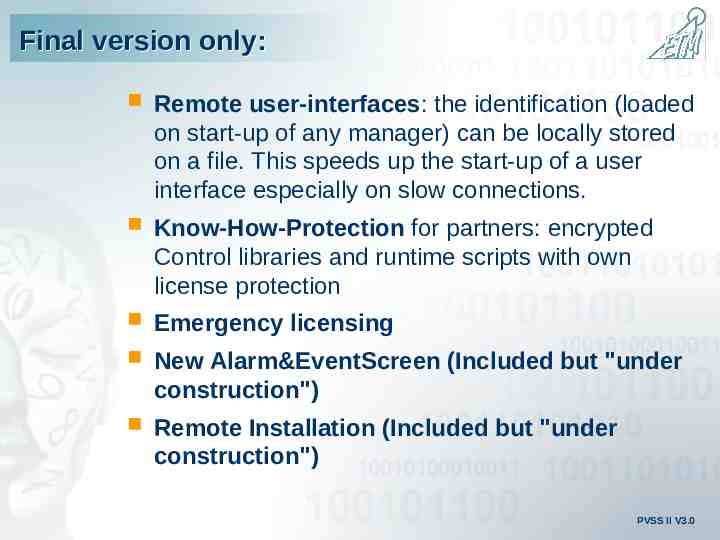
Final version only: Remote user-interfaces: the identification (loaded on start-up of any manager) can be locally stored on a file. This speeds up the start-up of a user interface especially on slow connections. Know-How-Protection for partners: encrypted Control libraries and runtime scripts with own license protection Emergency licensing New Alarm&EventScreen (Included but "under construction") Remote Installation (Included but "under construction") PVSS II V3.0

Profit from an Idea PVSS II V3.0






